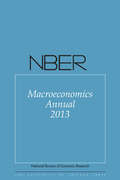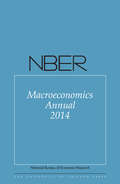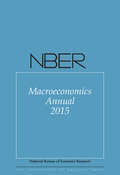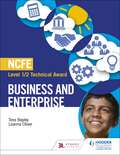- Table View
- List View
NASA and the Space Industry (New Series in NASA History)
by Joan Lisa BrombergA timely exploration of the relationships between NASA and the private sector: “An interesting read.” —SpaceflightFew federal agencies have more extensive ties to the private sector than NASA. NASA’s relationships with its many aerospace industry suppliers of rocket engines, computers, electronics, gauges, valves, O-rings, and other materials have often been described as “partnerships.” These have produced a few memorable catastrophes, but mostly technical achievements of the highest order. Until now, no one has written extensively about them.In NASA and the Space Industry, Joan Lisa Bromberg explores how NASA’s relationship with the private sector developed and how it works. She outlines the various kinds of expertise public and private sectors brought to the tasks NASA took on, describing how this division of labor changed over time. She explains why NASA sometimes encouraged and sometimes thwarted the privatization of space projects and describes the agency’s role in the rise of such new space industries as launch vehicles and communications satellites.
NASB, Charles F. Stanley Life Principles Bible, 2nd Edition, Ebook: Holy Bible, New American Standard Bible
by Thomas NelsonThe Charles F. Stanley Life Principles Bible, with over a million sold to date, is designed to lead believers into a life-changing relationship with Jesus Christ, and to help them experience the Good News about God&’s mighty kindness and love. The updated second edition is the best way to experience this bestselling classic—with a completely new design featuring our easy-to-read Comfort Print typeface, 100 specially designed maps and charts that bring biblical places and themes to life, and over 43,000 cross references to enrich your study of the Word.Features include:30 Life Principles articles highlight Dr. Stanley&’s essentials for Christian livingMore than 2,500 Life Lessons verse notes bring to life the practical and personal nature of God&’s Word to usA listing of over 300 verses revealing God&’s promises throughout the Bible that encourage, strengthen, and bring hopeAnswers to Life's Questions and What the Bible Says About articles bring scriptural insight to bear on topics of special importance to every believerTopical indexes give immediate access to hundreds of life-giving principles and promises throughout the Old and New TestamentsBook introductions provide an overview of the themes and literary structure of each book and alert readers to important principles they&’ll encounter as they readNew for the 2nd Edition, 100 maps and charts that help important biblical places and themes come alive and over 43,000 cross references to enrich your study
NATO at 70: A Political Economy Perspective
by Keith HartleyNATO is facing a unique crisis questioning its existence and future. This book provides a detailed in-depth economic and critical analysis of the issues. It considers whether NATO has a future and what it might look like 70 years ahead. NATO is undergoing a process of dramatic change, reorganising its functions, funding and strategic responsibilities to address growing regional and global threats. This book not only explores the contentiousness of economic and financial burden-sharing and the associated political and diplomatic stresses involved in the pursuit of common strategic objectives, but contributes to a further debate concerning the expanded scope and roles of the Alliance in the 21st century. This book combines NATO’s political controversies, complexities and conflicts with a treatment of the underlying theoretical economic frameworks. This book is essential reading for students in military staff colleges, university International Relations and Strategic Affairs Departments, but also to those working in government defence establishments, independent think tanks and political and economic institutions, generally.
NBCUniversal
by Anita ElberseIn September 2014, Stephen Burke, chief executive officer at lmedia and entertainment company NBCUniversal, has to decide between possible priorities for the company's 'Project Symphony,' guaranteeing the winners a high level of visibility and support across the media conglomerate's broadcast and cable television, film, and theme park divisions. Past "Gold" priorities for Symphony, an initiative introduced shortly after Comcast made steps to acquire NBCUniversal in 2010, saw subsequent success in the marketplace. Symphony is so powerful, in fact, that competing conglomerates are keen to buy some of NBCUniversal's cross-promotional strength, as Disney did with its megahit Frozen in 2014. For 2015, the choice is between five films-Fast & Furious 7, Fifty Shades of Grey, Jurassic World, Minions, and Pitch Perfect 2-as well as two choices in television. Which are most deserving of Gold status?
NBCUniversal
by Anita ElberseIn September 2014, Stephen Burke, chief executive officer at lmedia and entertainment company NBCUniversal, has to decide between possible priorities for the company's 'Project Symphony,' guaranteeing the winners a high level of visibility and support across the media conglomerate's broadcast and cable television, film, and theme park divisions. Past "Gold" priorities for Symphony, an initiative introduced shortly after Comcast made steps to acquire NBCUniversal in 2010, saw subsequent success in the marketplace. Symphony is so powerful, in fact, that competing conglomerates are keen to buy some of NBCUniversal's cross-promotional strength, as Disney did with its megahit Frozen in 2014. For 2015, the choice is between five films-Fast & Furious 7, Fifty Shades of Grey, Jurassic World, Minions, and Pitch Perfect 2-as well as two choices in television. Which are most deserving of Gold status?
NBER Macroeconomics Annual 2013: Volume 28
by Michael Woodford Jonathan ParkerThe twenty-eighth edition of the NBER Macroeconomics Annual continues its tradition of featuring theoretical and empirical research on central issues in contemporary macroeconomics. As in previous years, this volume not only addresses recent developments in macroeconomics, but also takes up important policy-relevant questions and opens new debates that will continue for years to come. The first two papers in this year's issue tackle fiscal and monetary policy, asking how interest rates and inflation can remain low despite fiscal policy behavior that appears inconsistent with a monetary policy regime focused only on inflation and output and not on fiscal balances as recently observed in the U.S. The third examines the implications of reference-dependent preferences and moral hazard in employment fluctuations in the labor market. The fourth paper addresses money and inflation, analyzing the long run inflation rate, the coexistence of money with pledgeable and money-like assets, and why inflation did not increase in response to business-cycle fluctuations in productivity. And the fifth looks at the stock market and how it relates to the real economy. The final chapter discusses the large and public shift towards more expansionary monetary policy that has recently occurred in Japan.
NBER Macroeconomics Annual 2013: Volume 28 (National Bureau of Economic Research Macroeconomics Annual #28)
by The University of Chicago PressThe twenty-eighth edition of the NBER Macroeconomics Annual continues its tradition of featuring theoretical and empirical research on central issues in contemporary macroeconomics. As in previous years, this volume not only addresses recent developments in macroeconomics, but also takes up important policy-relevant questions and opens new debates that will continue for years to come. The first two papers in this year’s issue tackle fiscal and monetary policy, asking how interest rates and inflation can remain low despite fiscal policy behavior that appears inconsistent with a monetary policy regime focused only on inflation and output and not on fiscal balances as recently observed in the U.S. The third examines the implications of reference-dependent preferences and moral hazard in employment fluctuations in the labor market. The fourth paper addresses money and inflation, analyzing the long run inflation rate, the coexistence of money with pledgeable and money-like assets, and why inflation did not increase in response to business-cycle fluctuations in productivity. And the fifth looks at the stock market and how it relates to the real economy. The final chapter discusses the large and public shift towards more expansionary monetary policy that has recently occurred in Japan.
NBER Macroeconomics Annual 2014
by Michael Woodford Jonathan ParkerThe twenty-ninth edition of the NBER Macroeconomics Annual continues its tradition of featuring theoretical and empirical research on central issues in contemporary macroeconomics. Two papers in this year's issue deal with recent economic performance: one analyzes the evolution of aggregate productivity before, during, and after the Great Recession, and the other characterizes the factors that have contributed to slow economic growth following the Great Recession. Another pair of papers tackles the role of information in business cycles. Other contributions address how assumptions about sluggish nominal price adjustment affect the consequences of different monetary policy rules and the role of business cycles in the long-run decline in the share of employment in middle-wage jobs. The final chapter discusses the advantages and disadvantages of the elimination of physical currency.
NBER Macroeconomics Annual 2014: Volume 29 (National Bureau of Economic Research Macroeconomics Annual #29)
by The University of Chicago PressThe twenty-ninth edition of the NBER Macroeconomics Annual continues its tradition of featuring theoretical and empirical research on central issues in contemporary macroeconomics. Two papers in this year’s issue deal with recent economic performance: one analyzes the evolution of aggregate productivity before, during, and after the Great Recession, and the other characterizes the factors that have contributed to slow economic growth following the Great Recession. Another pair of papers tackles the role of information in business cycles. Other contributions address how assumptions about sluggish nominal price adjustment affect the consequences of different monetary policy rules and the role of business cycles in the long-run decline in the share of employment in middle-wage jobs. The final chapter discusses the advantages and disadvantages of the elimination of physical currency.
NBER Macroeconomics Annual 2015: Volume 30 (National Bureau of Economic Research Macroeconomics Annual #30)
by The University of Chicago PressThis year, the NBER Macroeconomics Annual celebrates its thirtieth volume. The first two papers examine China’s macroeconomic development. “Trends and Cycles in China's Macroeconomy” by Chun Chang, Kaiji Chen, Daniel F. Waggoner, and Tao Zha outlines the key characteristics of growth and business cycles in China. “Demystifying the Chinese Housing Boom” by Hanming Fang, Quanlin Gu, Wei Xiong, and Li-An Zhou constructs a new house price index, showing that Chinese house prices have grown by ten percent per year over the past decade. The third paper, “External and Public Debt Crises” by Cristina Arellano, Andrew Atkeson, and Mark Wright, asks why there appear to be large differences across countries and subnational jurisdictions in the effect of rising public debts on economic outcomes. The fourth, “Networks and the Macroeconomy: An Empirical Exploration” by Daron Acemoglu, Ufuk Akcigit, and William Kerr, explains how the network structure of the US economy propagates the effect of gross output productivity shocks across upstream and downstream sectors. The fifth and sixth papers investigate the usefulness of surveys of household’s beliefs for understanding economic phenomena. “Expectations and Investment,” by Nicola Gennaioli, Yueran Ma, and Andrei Shleifer, demonstrates that a chief financial officer's expectations of a firm's future earnings growth is related to both the planned and actual future investment of that firm. “Declining Desire to Work and Downward Trends in Unemployment and Participation” by Regis Barnichon and Andrew Figura shows that an increasing number of prime-age Americans who are not in the labor force report no desire to work and that this decline accelerated during the second half of the 1990s.
NBER Macroeconomics Annual 2016 (National Bureau of Economic Research Macroeconomics Annual)
by The University of Chicago PressThe thirty-first edition of the NBER Macroeconomics Annual features theoretical and empirical research on central issues in contemporary macroeconomics. The first two papers are rigorous and data-driven analyses of the European financial crisis. The third paper introduces a new set of facts about economic growth and financial ratios as well as a new macrofinancial database for the study of historical financial booms and busts. The fourth paper studies the historical effects of Federal Reserve efforts to provide guidance about the future path of the funds rate. The fifth paper explores the distinctions between models of price setting and associated nominal frictions using data on price setting behavior. The sixth paper considers the possibility that the economy displays nonlinear dynamics that lead to cycles rather than long-term convergence to a steady state. The volume also includes a short paper on the decline in the rate of global economic growth.
NBER Macroeconomics Annual 2017: Volume 32 (National Bureau of Economic Research Macroeconomics Annual #32)
by The University of Chicago PressVolume 32 of the NBER Macroeconomics Annual features six theoretical and empirical studies of important issues in contemporary macroeconomics, and a keynote address by former IMF chief economist Olivier Blanchard. In one study, SeHyoun Ahn, Greg Kaplan, Benjamin Moll, Thomas Winberry, and Christian Wolf examine the dynamics of consumption expenditures in non-representative-agent macroeconomic models. In another, John Cochrane asks which macro models most naturally explain the post-financial-crisis macroeconomic environment, which is characterized by the co-existence of low and nonvolatile inflation rates, near-zero short-term interest rates, and an explosion in monetary aggregates. Manuel Adelino, Antoinette Schoar, and Felipe Severino examine the causes of the lending boom that precipitated the recent U.S. financial crisis and Great Recession. Steven Durlauf and Ananth Seshadri investigate whether increases in income inequality cause lower levels of economic mobility and opportunity. Charles Manski explores the formation of expectations, considering the efficacy of directly measuring beliefs through surveys as an alternative to making the assumption of rational expectations. In the final research paper, Efraim Benmelech and Nittai Bergman analyze the sharp declines in debt issuance and the evaporation of market liquidity that coincide with most financial crises. Blanchard’s keynote address discusses which distortions are central to understanding short-run macroeconomic fluctuations.
NBER Macroeconomics Annual 2018: Volume 33 (National Bureau of Economic Research Macroeconomics Annual #33)
by The University of Chicago PressThis volume contains six studies on current topics in macroeconomics. The first shows that while assuming rational expectations is unrealistic, a finite-horizon forward planning model can yield results similar to those of a rational expectations equilibrium. The second explores the aggregate risk of the U.S. financial sector, and in particular whether it is safer now than before the 2008 financial crisis. The third analyzes “factorless income,” output that is not measured as capital or labor income. Next, a study argues that the financial crisis increased the perceived risk of a very bad economic and financial outcome, and explores the propagation of large, rare shocks. The next paper documents the substantial recent changes in the manufacturing sector and the decline in employment among prime-aged Americans since 2000. The last paper analyzes the dynamic macroeconomic effects of border adjustment taxes.
NBER Macroeconomics Annual 2019: Volume 34 (National Bureau of Economic Research Macroeconomics Annual #34)
by The University of Chicago PressThe thirty-fourth volume of the NBER Macroeconomics Annual features theoretical and empirical studies of issues in contemporary macroeconomics and a keynote address by James Stock, a member of President Obama’s Council of Economic Advisers from 2013 to 2014. Chong-en Bai, Chang-Tai Hsieh, and Zheng Song examine the “special deals” provided by Chinese local governments to favored private firms and their effects on economic growth. Matias Covarrubias, Germán Gutiérrez, and Thomas Philippon study the evolution of profits, investment, and market shares in US industries over the past forty years and find evidence of inefficient concentration and barriers to entry since 2000. David Debortoli, Jordi Galí, and Luca Gambetti assess whether recent economic performance was affected by a binding zero lower bound constraint on the interest rate. Michael McLeay and Silvana Tenreyro explain why it is difficult to empirically identify the Phillips curve (a key element of the policy framework used by central banks) using aggregate data. The authors suggest using regional variation in unemployment and inflation to estimate the relationship between these variables. Margherita Borella, Mariacristina De Nardi, and Fang Yang examine the effects of shorter life expectancies, higher medical expenses, and lower wages for white, non-college-educated Americans born in the 1960s on labor supply and retirement savings. Nir Jaimovich, Sergio Rebelo, Arlene Wong, and Miao Ben Zhang investigate the role that increases in the quality of the goods consumed (“trading up”) played in the rise of the skill premium that occurred in the last four decades.
NBER Macroeconomics Annual, 2022: Volume 37 (National Bureau of Economic Research Macroeconomics Annual #37)
by The University of Chicago PressAuthoritative takes on the most current and pressing issues in macroeconomics today. The NBER Macroeconomics Annual provides a forum for leading economists to participate in important debates in macroeconomics and to report on major developments in macroeconomic analysis and policy. The NBER Macroeconomics Annual brings together leading scholars to discuss five research papers on central issues in contemporary macroeconomics. First, Andrea Eisfeldt, Antonio Falato, and Mindy Xiaolan document the rise of a new class of worker that receives part of its labor income as equity-based compensation, its role in the recent decline in the labor share of income, and implications for the returns to skilled labor and the implied capital-skill complementarity. Next, Michael Bauer and Eric Swanson focus on monetary policy shocks and argue the correlation between estimated monetary surprises and previously available information can be explained by uncertainty about the parameters of the monetary policy rule. Using new data and methods they find effects of monetary policy on macroeconomic variables that are much larger than previously estimated. Job Boerma and Loukas Karabarbounis provide a framework for quantitatively exploring the gap in wealth between White and Black Americans over the past 150 years and examine the effectiveness of reparations as a tool for closing this gap. Guido Menzio considers workers who do not have rational expectations, and whose “stubborn” beliefs change the response of wages to technology shocks, resulting in sticky wages. He finds that the larger the fraction of workers with stubborn beliefs, the more volatile unemployment is. Finally, Rishabh Aggarwal, Adrien Auclert, Matthew Rognlie, and Ludwig Straub investigate the growth—particularly in the United States—of private savings, current account deficits, and fiscal deficits after 2020. They argue that fiscal deficits lead to large and persistent increases in private savings and current account deficits.
NBER Macroeconomics Annual, 2022: Volume 37 (National Bureau of Economic Research Macroeconomics Annual #37)
by The University of Chicago PressAuthoritative takes on the most current and pressing issues in macroeconomics today. The NBER Macroeconomics Annual provides a forum for leading economists to participate in important debates in macroeconomics and to report on major developments in macroeconomic analysis and policy. The NBER Macroeconomics Annual brings together leading scholars to discuss five research papers on central issues in contemporary macroeconomics. First, Andrea Eisfeldt, Antonio Falato, and Mindy Xiaolan document the rise of a new class of worker that receives part of its labor income as equity-based compensation, its role in the recent decline in the labor share of income, and implications for the returns to skilled labor and the implied capital-skill complementarity. Next, Michael Bauer and Eric Swanson focus on monetary policy shocks and argue the correlation between estimated monetary surprises and previously available information can be explained by uncertainty about the parameters of the monetary policy rule. Using new data and methods they find effects of monetary policy on macroeconomic variables that are much larger than previously estimated. Job Boerma and Loukas Karabarbounis provide a framework for quantitatively exploring the gap in wealth between White and Black Americans over the past 150 years and examine the effectiveness of reparations as a tool for closing this gap. Guido Menzio considers workers who do not have rational expectations, and whose “stubborn” beliefs change the response of wages to technology shocks, resulting in sticky wages. He finds that the larger the fraction of workers with stubborn beliefs, the more volatile unemployment is. Finally, Rishabh Aggarwal, Adrien Auclert, Matthew Rognlie, and Ludwig Straub investigate the growth—particularly in the United States—of private savings, current account deficits, and fiscal deficits after 2020. They argue that fiscal deficits lead to large and persistent increases in private savings and current account deficits.
NBER Macroeconomics Annual, 2024: Volume 39 (National Bureau of Economic Research Macroeconomics Annual #39)
by The University of Chicago PressProvides a forum for leading economists to participate in important debates in macroeconomics and to report on major developments in macroeconomic analysis and policy. The NBER Macroeconomics Annual presents research on central issues in contemporary macroeconomics. Martin Kornejew, Chen Lian, Yueran Ma, Pablo Ottonello, and Diego Perez investigate the role of bankruptcy institutions in mitigating the economic fallout of credit crunches following booms and find that efficient institutions reduce the adverse effect of credit tightening on GDP. Santiago Camara, Lawrence Christiano, and Hüsnü Dalgic analyze the global effects of US monetary policy shocks, with particular attention to trade channels and financial frictions, and find that tighter US monetary policy leads to more pronounced contractions in emerging markets than in advanced economies. David Altig, Alan Auerbach, Erin Eidschun, Laurence Kotlikoff, and Victor Yifan Ye assess the welfare costs of inflation through interactions with tax and benefit programs and show that imperfect indexation leads to welfare losses for some households and gains for others. Paul Beaudry, Chenyu Hou, and Franck Portier examine inflation dynamics, and find that supply shocks and inflation expectations are pivotal for explaining them. Finally, Davide Debortoli and Jordi Galí develop a simplified two-agent new Keynesian (TANK) model to emulate more complex heterogeneous agent new Keynesian (HANK) models, and use it to examine the many channels through which heterogeneity influences aggregate fluctuations.
NCERT Snapshots
by National Council of Educational Research and TrainingThe methods used for teaching and evaluation will also determine how effective this supplementary reader proves for making children’s life at school a happy experience, rather than a source of stress or boredom. Syllabus designers have tried to address the problem of curricular burden by restructuring and reorienting knowledge at different stages with greater consideration for child psychology and the time available for teaching. The book attempts to enhance this endeavour by giving higher priority and space to opportunities for contemplation and wondering, discussion in small groups
NCFE Level 1/2 Technical Award in Business and Enterprise
by Tess Bayley Leanna OliverBuild your knowledge and develop the practical enterprise skills you need to achieve the Level 1/2 Technical Award with this brand new textbook, endorsed by NCFE and written by business and enterprise experts Tess Bayley and Leanna Oliver.- Access the information you need using the clear and attractive layout. - Test your knowledge and understanding, with activities and Test Yourself questions throughout.- Reinforce the knowledge and skills you need for both the written exam and synoptic project.- Endorsed by NCFE for the 2018 specification, which is approved for inclusion in the 2020, 2021 and 2022 Key Stage 4 performance tables.
NCFE Level 1/2 Technical Award in Business and Enterprise
by Tess Bayley Leanna OliverBuild your knowledge and develop the practical enterprise skills you need to achieve the Level 1/2 Technical Award with this brand new textbook, endorsed by NCFE and written by business and enterprise experts Tess Bayley and Leanna Oliver.- Access the information you need using the clear and attractive layout. - Test your knowledge and understanding, with activities and Test Yourself questions throughout.- Reinforce the knowledge and skills you need for both the written exam and synoptic project.- Endorsed by NCFE for the 2018 specification, which is approved for inclusion in the 2020, 2021 and 2022 Key Stage 4 performance tables.
NCFE Level 1/2 Technical Award in Business and Enterprise Second Edition
by Tess Bayley Leanna OliverThis Student Textbook is:- Comprehensive - gain in-depth knowledge of each content area with clear explanations of every concept and topic and easy-to-follow chapters.- Accessible, reliable and trusted - structured to match the specification and provide you with the information you need to build knowledge, understanding and skills.- Designed to support you - boost your confidence when tackling the internal non-examined and external examined assessments with plenty of activities to test and consolidate knowledge.- Your go-to guide - expert authors have carefully designed tasks and activities to build your skillset in order to aid progression and questions to assess understanding.
NCFE Level 1/2 Technical Award in Business and Enterprise Second Edition
by Tess Bayley Leanna OliverThis Student Textbook is:- Comprehensive - gain in-depth knowledge of each content area with clear explanations of every concept and topic and easy-to-follow chapters.- Accessible, reliable and trusted - structured to match the specification and provide you with the information you need to build knowledge, understanding and skills.- Designed to support you - boost your confidence when tackling the internal non-examined and external examined assessments with plenty of activities to test and consolidate knowledge.- Your go-to guide - expert authors have carefully designed tasks and activities to build your skillset in order to aid progression and questions to assess understanding.
NCIDQ Interior Design Reference Manual
by David Kent BallastComprehensive review for all three exam sections The Interior Design Reference Manual by David Ballast covers all three sections of the NCIDQ exams which include the fundamentals (IDFX), professional (IDPX), and practicum (PRAC) sections. Pass your exams the first time with comprehensive reading materials on all topics. The NCIDQ Interior Design Reference Manual features include: Complete coverage of content areas for all three sections of the NCIDQ Exam Updated for the IBC 2018 changes included in the exam Over 200 figures in SI and U.S. measurements to illustrate design details Study guidelines, exam tips, and tables to support exam preparation New for this edition - revised and updated content to increase exam specification coverage Interior Design Topics Covered Design Concepts and Programming Design Constraints Building Systems and Construction Research, Analysis, and Selection of Products and Details Communication and Documentation Project and Business Management
NEC Electronics
by James Quinn Robin Greenwood C. Fritz FoleyWhy do shares in NEC Electronics, a publicly listed subsidiary of Japan conglomerate NEC trade at a discount to their fundamental value? Can Perry Capital, a U.S. hedge fund, restructure this subsidiary and generate significant returns? This case provides students with an opportunity to analyze Perry's decision to invest in NEC Electronics. In doing so, it asks for the reasons that NEC might take actions that destroy value and shift value away from NECE's minority shareholders. The events covered allow for a discussion of how ownership concentration constrains restructuring alternatives, how hedge fund investors might confront controlling shareholders, and how the mispricing of agency costs can give rise to ownership structures that allow for minority shareholder expropriation.
NEC4: 100 Questions and Answers
by Kelvin HughesThis book details some of the most important and interesting questions raised about the NEC4 family of contracts and provides clear, comprehensive answers to those questions. Written by an NEC expert with over 20 years’ experience using, advising and training others, the book has several distinctive features: It covers the whole NEC4 family It is written by a very experienced NEC author who explains sometimes complex issues in a simple and accessible style The questions and answers range from beginner level up to a masterclass level The questions are real life questions asked by actual NEC practitioners on real projects. The book includes questions and answers relating to tendering, early warnings, programme issues, quality management, payment provisions, compensation events, liabilities, insurances, adjudication, termination and much more. It is essential reading for anyone working with the NEC4 family of contracts, whether professionals or students in construction, architecture, project management and engineering.
















